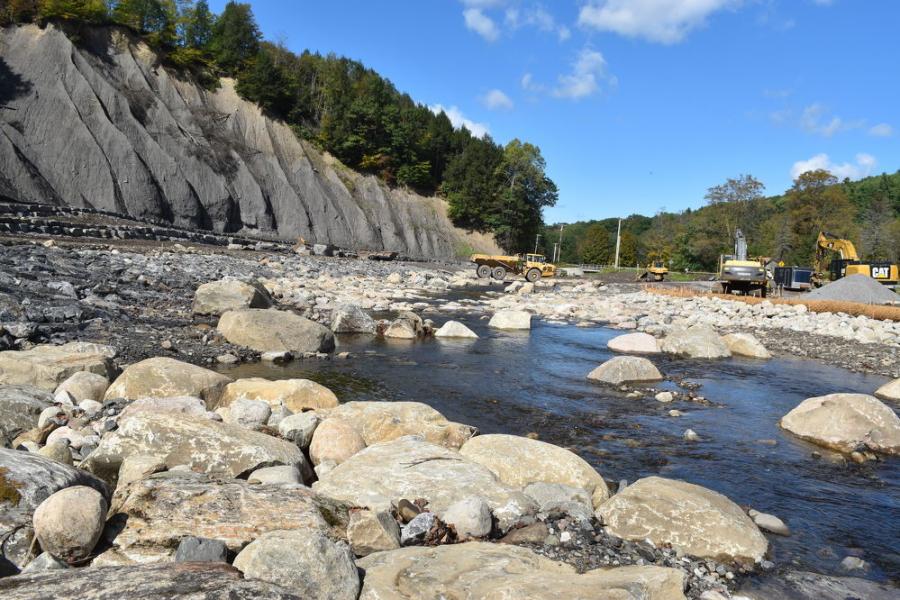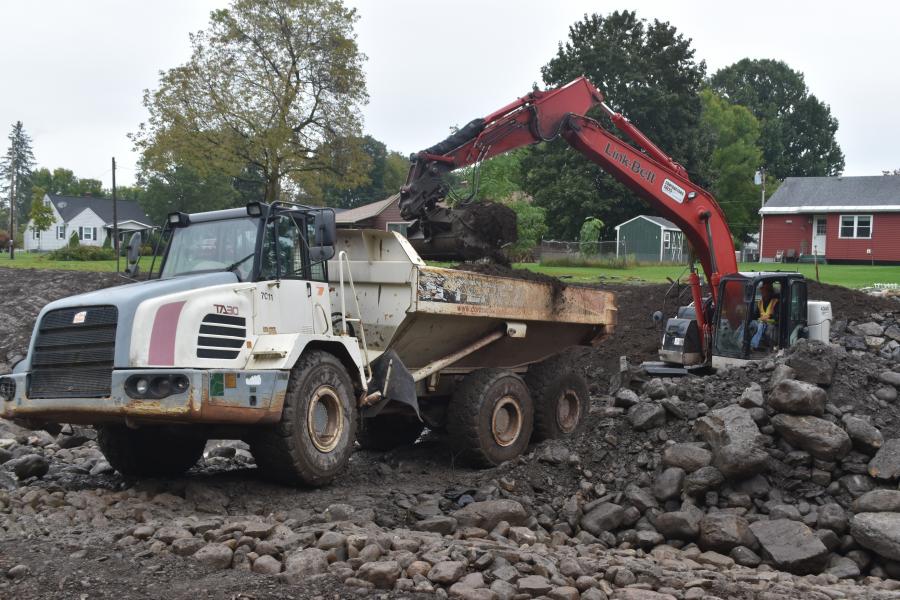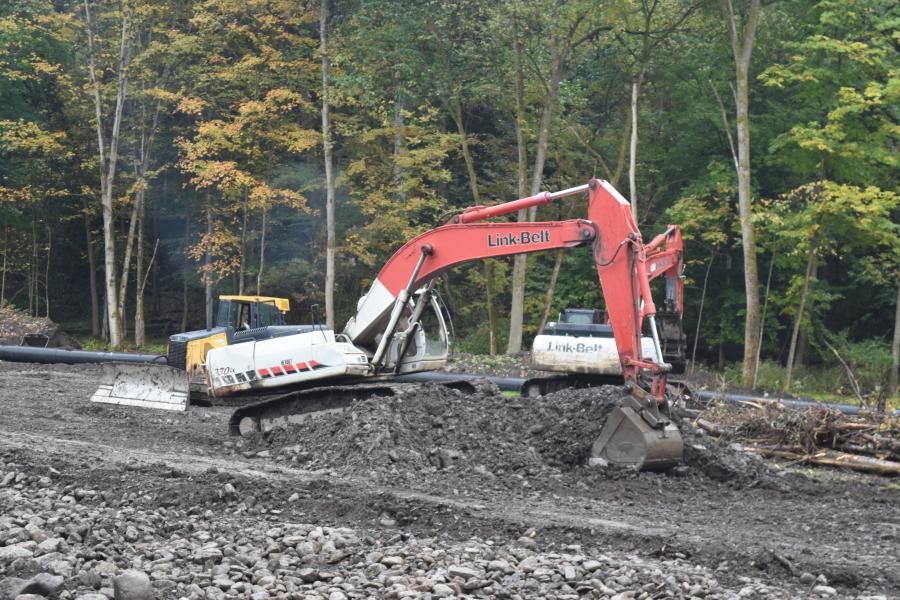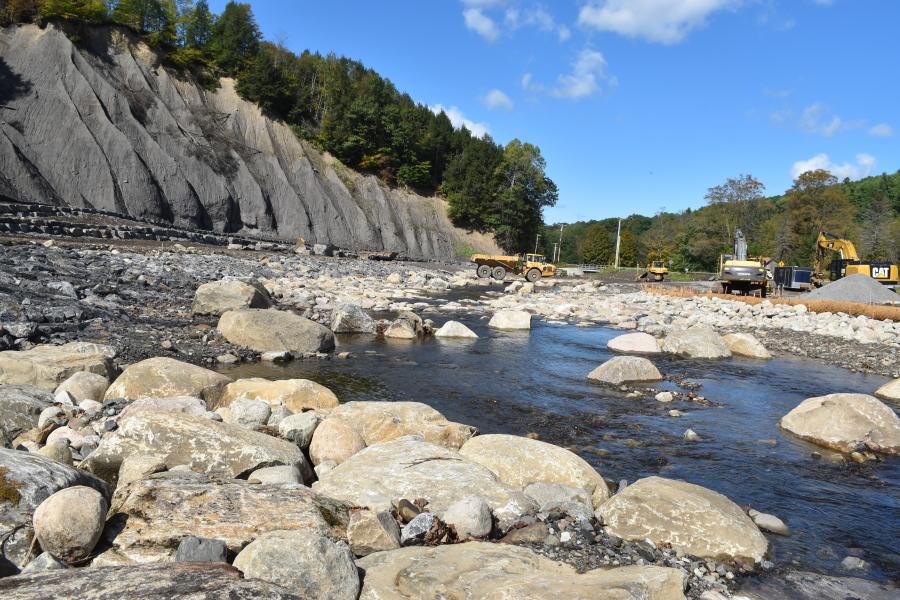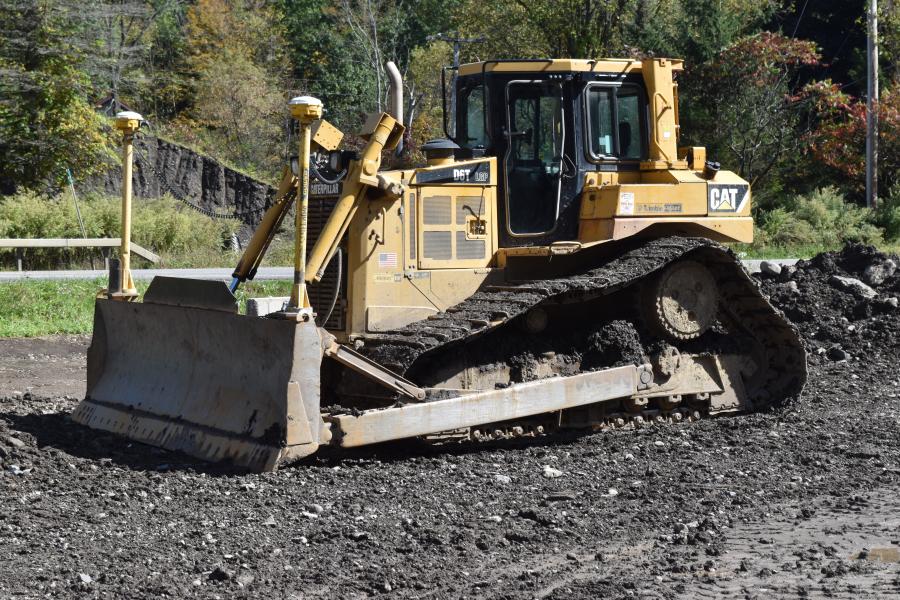Today’s path of the Fulmer Creek has been rerouted from its original destructive path. Although the boulders may appear to be haphazard, each one has been strategically placed with GPS precision to avoid future floods.
Since 2006 the Town of German Flatts, N.Y., has seen what used to be referred to as "100-year floods" at least three times, the worst of these occurring in 2006 and 2013.
Most of the flood damage was caused by the Fulmer Creek, which flows into the Mohawk River, as well as flooding from the Mohawk River itself. This area of central New York commonly referred to as the "Mohawk Valley" is an area where the Catskill Mountains meet the foothills of the Adirondack Mountains and are separated by the Mohawk River. The hills and mountains in this region are lined with streams and small rivers that feed the Mohawk River. During the spring snow thaw season these bodies of water can become fast moving torrents but typically once that season passes you can walk across them.
In the periods leading up to each of these severe floods, there had been record-breaking prolonged rainy seasons that had super saturated the ground, followed by a super rain event that stalled over the area producing several inches of rain.
The result was massive amounts of water coming down these hills and mountains that picked up a lot of debris, including boulders the size of a truck and mature trees that they pushed along with them as they came.
As this debris hit roadways it clogged culverts, ultimately blowing them out, which created bigger rushes of water that would hit the next bridge or culvert, creating even more damage, and resulting in significant destruction to the villages and cities along the Mohawk River, destroying homes and infrastructures. To make matters worse, the flooding of the Mohawk River put the entire region under several feet of muddy, fast-moving muck.
The 2006 flood in some areas changed the course and flow of creeks like Fulmer Creek, which runs through the town of German Flatts, and as the waters receded, left large deposits of whole trees and branches along with piles of rocks and boulders that were not intended to be there.
Due to concerns for fish and wildlife, New York State's Department of Environmental Conservation provided very little time for these deposited materials to be removed and, in many cases, they ended up being left behind, only to create an even bigger problem when the next flooding event occurred.
FEMA money was made readily available to quickly repair roads, bridges, culverts and other infrastructure damage that was needed to get the communities back up and running. Further down the road, money flowed that helped homeowners get back on their feet. But, as the floods continued to occur, it became evident to town officials that part of the problem was now the flow and layout of the Fulmer Creek, and if it was not adjusted at a considerable cost, the problem would continue to reoccur.
Construction Equipment Guide met with Peter Rovazzi, Town of German Flatts supervisor, to discuss the Leatherstocking Flood Plain Project, which has been designed and funded to hopefully relieve future flooding issues. The project would restore the flood plain along the Fulmer Creek in the Village of Mohawk, N.Y., for several miles upstream into the Town of German Flatts.
The plan was put together with the combined efforts of Herkimer/Oneida counties Comprehensive Planning Program, Templeton Landscape Architects and the State Department of Environmental Conservation, along with the Army Corps. of Engineers.
Essentially the problem being addressed is that when too much water comes through the Fulmer Creek, the channel is too narrow to handle the flow and water spills over it. The project would create a shelf that would allow it to spread out and pass through without destroying homes and businesses.
Currently two different phases of the project are being worked on.
"On Route 168, a couple of miles outside of the Village of Mohawk, we have an area where the flood plain problem has been compounded by a high bank failure," Rovazzi said. "Essentially a bank that is at least 60 feet above the creek that has no growth on the bank stabilizing it, is continuously eroding into the creek. In this part of the project, Marcy Excavation Services LLC. from Herkimer, N.Y., is actually moving the flow of the stream away from that bank and lowering the flow of the stream, giving it several tiers of elevation to flood before it can erode into that bank."
In the Village of Mohawk, Hubbell Inc. is handling a separate phase of the project, which is referred to as the "Fulmer Creek Greenplain Floodplain Restoration and Mitigation Project."
"Both of these companies have been amazing to work with," Rovazzi said. "They have been extremely responsive to our needs and the needs of our residents. Because Hubbell's project is located entirely within the village, I have not had nearly as much interaction with their employees. But, when I have needed anything from either company they have never let us down."
Hubbell Inc.
Hubbell Inc., which is located in Margaretville, N.Y., along with its sister companies, Catskill Rental and Hubbell Logging & Land Clearing, has a long history with the Catskill region of New York State.
"In 1848, Milow Hubbell and his son John started a farm, adding a saw mill, cider mill and granary. The next generations added a hardware store, lumber store, machine shop and a car dealership. Six generations later, the Hubbell family homestead is still in operation and the Hubbell family has diversified into several other businesses, including logging, land clearing, site development, landscaping, excavation and, what Hubbell Inc. is best known for, stream restoration."
In 1996, the Catskill region was devastated by severe flooding. Brothers Toby and Rudd Hubbell found themselves neck deep in learning flood cleanup and later on down the road, stream restoration — or the art of putting streams back together — the hard way.
"This work is not for the faint of heart, and with it comes dealing with a whole lot of bureaucracy. But it's a niche that we have developed a reputation for and the weather conditions in upstate New York since 1996 have kept us very busy," said Toby Hubbell, who is heading up the work of restoring Fulmer Creek.
Fulmer Creek Greenplain Floodplain Restoration and Mitigation Project
The purpose of the Fulmer Creek Greenplain Floodplain Restoration and Mitigation Project is to expand the size of the flood plain to give the water more room and to place grade control structures to keep the gravel in the stream bed at the correct elevation, and then rip rapping the bank to hold the material on the bank so it doesn't erode into the bank.
When it has flooded in the past, this section of Fulmer Creek has done a tremendous amount of damage to homes in the village. Looking to eliminate this problem in the long term, homes that received significant water damage in the past were condemned and removed and a plan was laid out for Hubbell to execute that would give the water a broader area to expand to without doing flood damage, and also create geographical structures to slow down the flow of the water.
Once the damaged homes were removed, the flood plains around the creek were significantly expanded and plateaus were created at various levels to contain the flow of water as water levels increased. During this process, approximately 9,000 yards of material had to be removed and hauled off site, 5,000 tons of rock was hauled in and 500 tons of cobble was hauled in.
One of these geographical structures is a U-shaped single boulder riffle structure. This structure, which comes into effect when high volumes of water start to come through the stream, pushes water back into the center of the stream. This will slow down bank erosion during a flooding event and it also helps hold the gravel into the stream.
Another natural structure that Hubbell is placing within the newly re-created stream bed to help control flooding involves burying trees in the stream bed. These trees or partial trees are called root wads.
Twenty feet of tree trunk and its root system is buried at a very specific angle along the bank of the stream with 6 to 12 in. cobbles. The tree and the cobbles catch gravel and other deposits as they come rushing down the stream during a flooding situation and prevents them from being redeposited out in the river. Left unchecked, these deposits would create the potential for flooding hazards in the Mohawk River.
In order to accomplish all of this excavating work the flow of the Fulmer Creek had to be diverted using a pumping system.
Late in the summer on a dry day the pump is only required to move about 8 cu. ft. of water per second, and that water is being pumped about 1,000 ft. The pump is capable of pumping 15 cu. ft. per second.
Flood Control Techniques
A variety of different techniques for flood control are being used at this project, including a revetment, which is a 2-ft. thick medium stone covered with topsoil with willow branches planted in it. The willow branches will grow into willow trees and the root system will create a fabric type of netting that will create a retaining system or a natural way of protecting the bank.
In other sections the system of protecting the bank involves 2-ft. of cobble with a coir log placed to protect the bank edge. A coir log is a coconut fiber log that is staked into the top of the bank.
This aspect of the project was started the first week in August 2019 and was completed by mid-October 2019 and is valued at $1.5 million.
Serious Iron on the Job
Hubbell has a significant fleet of construction equipment at the Mohawk, N.Y., site, including three LBX excavators (a 350, a 330, and a 235 model); a Kawasaki 67 Z 7; a Terex TA30 ton articulated truck; a Takeuchi TB235 excavator; a Cat D6R dozer; and a John Deere 750 dozer.
"We have had some amazing successes with the LBX excavators," said Toby Hubbell. "Our 330 has over 10,000 hours on it without any significant failures. The 350 is one of our favorite machines because it gives us great cycle times. We've been running LBX machines for thirty years and have no regrets.
"When working in the Catskills we are typically working at least 1-1/2 hours away from any dealer support so that reliability is very important to us. The people at Contractors Sales Company have sold us equipment that allows us to effectively maintain our independence. On the occasion when we have needed support, Gerard Calamari and Scott Dubois at Contractors Sales Company have seen to it that despite the challenge of our location, we receive prompt and exceptional service."
All of the loaders in our fleet are Kawasaki, which were purchased before Hitachi bought the company, and Hubbell is confident the company will be buying Hitachi machines in the future.
"We have racked up a lot of hours on these machines and they have proven to be just as reliable as the LBX machines. All of the loaders are equipped with quick couplers so that we can easily switch out to forks and brooms as needed depending on the application."
Marcy Excavating Focuses on Redirection
A few miles east of the village of Mohawk on Route 168, Marcy Excavating has been focused on another aspect of redirecting the Fulmer Creek.
At this site, the Fulmer Creek was running alongside a 220-ft. high bank failure that is creating several problems. A tremendous amount of dirt and debris is continuously falling into the creek and being redeposited in other areas along the creek or into the Mohawk River and at the top of the bank, a property owner is losing a tremendous amount of property that is slowly moving towards his home. Given enough time, this would create a safety risk.
When the Fulmer Creek floods because the creek runs immediately next to the bank failure the erosion issue intensifies dramatically. The project consists of relocating 850-ft. of creek away from the 220-ft. high bank failure. The idea is to pull the creek away from the bank so it will stop eroding the toe of the slope. Hopefully over time it will correct itself and some vegetation will grow there.
The project includes the construction of a compound channel with a shelf and a floodplain bench and boulder revetments with live willow staking, and other geographical formations to help control the flow of the water. The stabilization includes riffle grade control structures, boulder deflector vanes, random channel roughness, random boulder clusters, stacked boulder wall with vegetated shelf, coir log with cobble toe and live staked boulder retaining walls.
This project called for Marcy Excavating Services to build this new creek while maintaining the flow of the existing creek until the new creek bed was completed. The real challenge was that in order to finish the creek relocation Marcy Excavating had to tie into the existing creek while not interrupting the flow.
"When we arrived at the project one of the initial challenges was that over the course of the erosion process all of the trees and brush at the top of the bank had fallen down and were spread across various parts of the project, some near the top of the bank, some halfway down, etc," said Jim Joy, Marcy Excavating site superintendent.
To clean up this mess Mohawk Valley Materials from Marcy, N.Y., was brought in
"I cannot speak highly enough of the work they did. They were very professional, very efficient and got in and out in a very timely manner. Handling the water flow was really our biggest challenge. We initially tried several different diesel-powered pump systems to pump and transport the water to divert the creek bed. What we were not prepared for was the dramatic increases in water flow that this creek experiences even under modest amounts of rainfall."
With flow rates that fluctuated between 5 cu. ft. per second to 150 cu. ft. per second, Marcy Excavation brought in Godwin Pumps.
"Ultimately, we had to bring in Godwin Pumps and move to a 30-inch electric pumping system, pumping the water over 600 feet. This system easily handled our normal flow of about 8 cubic feet per second, and the extremes that we experienced of 150 cubic feet per second as a result of a single day of rain did not set us back a week waiting for the water to get back to normal flows", Joy said.
By using the 30-inch bypass pump and building temporary stream crossings, Marcy Excavation was able to work on both sides of the existing creek without interrupting flow.
In redesigning the flow of this creek bed a lot of unusable material had to come out and a lot of new material had to come in, including 2,500 tons of boulder, 2,000 tons of retaining rock, and 2,700 tons of stackable rock, all of which came from multiple sources including, Weakley Sand and Gravel in Poland, N.Y., Hanson Aggregates in Jordanville, N.Y., and Barrett Paving Materials, Litchfield, N.Y.
"A significant amount of excavating was required in creating the new creek bed. We had to make a cut about 10 feet down and about 500 feet long," Joy said. "In other areas we are planting a significant number of willow trees into a base of rip rap and dirt. The roots of the willow trees combined with the dirt will create a very strong bank that will stop future erosion."
All along the new creek bed Marcy Excavation was given very specific geological formations to create to help control the flow of the water to prevent future flooding. Boulders needed to be put in place in spots so specifically that GPS was needed to determine exact location.
"For this type of work GPS grade control systems from Trimble were absolutely essential in finding our grade. These days we use grade control on virtually every job. On this particular project, Park East Sales gave us a Cat D6T that was perfectly equipped for this project. They also provided us with a Cat 930M loader that has proven to be a real work horse," Joy said.
"Three Marcy Excavation employees executed this entire job so relying on Park East Sales to handle all the service and maintenance on these machines has been essential. I also want to mention that we have received extraordinary cooperation from both the local DEC officials and members of the town government. Together we have worked as a team and have navigated some very challenging situations."
Marcy Excavation was founded in 1981 by Phil Hale and is operated today as a division of the Rifenburg Companies. The company originally built its reputation with the construction of wastewater treatment plants and in the late 80's and 90's it was well-known for building and expanding landfills and remodeling and closing landfills that had become environmental hazards. In the pursuing years it has continued to build its reputation in very diverse areas, including site development, school construction, athletic fields, while continuing to build its reputation in any area that includes environmental sensitivity.
Nearly all of Marcy Excavating's equipment needs are filled by Park East Sales of Troy, N.Y. Park East Sales sells, rents and/or leases equipment to construction companies across New York State and western New England depending on the situation. CEG
Today's top stories



